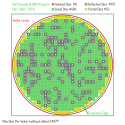There is a new RISC-V chip company called SpacemiT which has launched the K1 processor. 8-core RISC-V RVA22 compatible.
It uses their own design X60 core. Claimed to have 30% more performance than an ARM Cortex A55. So it should have similar performance to the A510. The chip also comes with an Imagination Technologies GPU.
This seems to be the first commercially available chip with RISC-V Vector 1.0 support.
There is a developer laptop with the chip:
There will also be a Banana Pi board with the chip:
This is the website for the CPU company:
The SpacemiT company founders come from Alibaba T-Head and Allwinner technology.
The company has received financing from Lenovo Capital and Legend Capital:
The X60 core seems to be a dual-issue in-order 9-stage pipeline core. RISC-V 64GCVB with 256-bit vector compute.
They also have the X100 core. Which is a quad-issue out-of-order core. This seems to be the product Lenovo is interested in.

